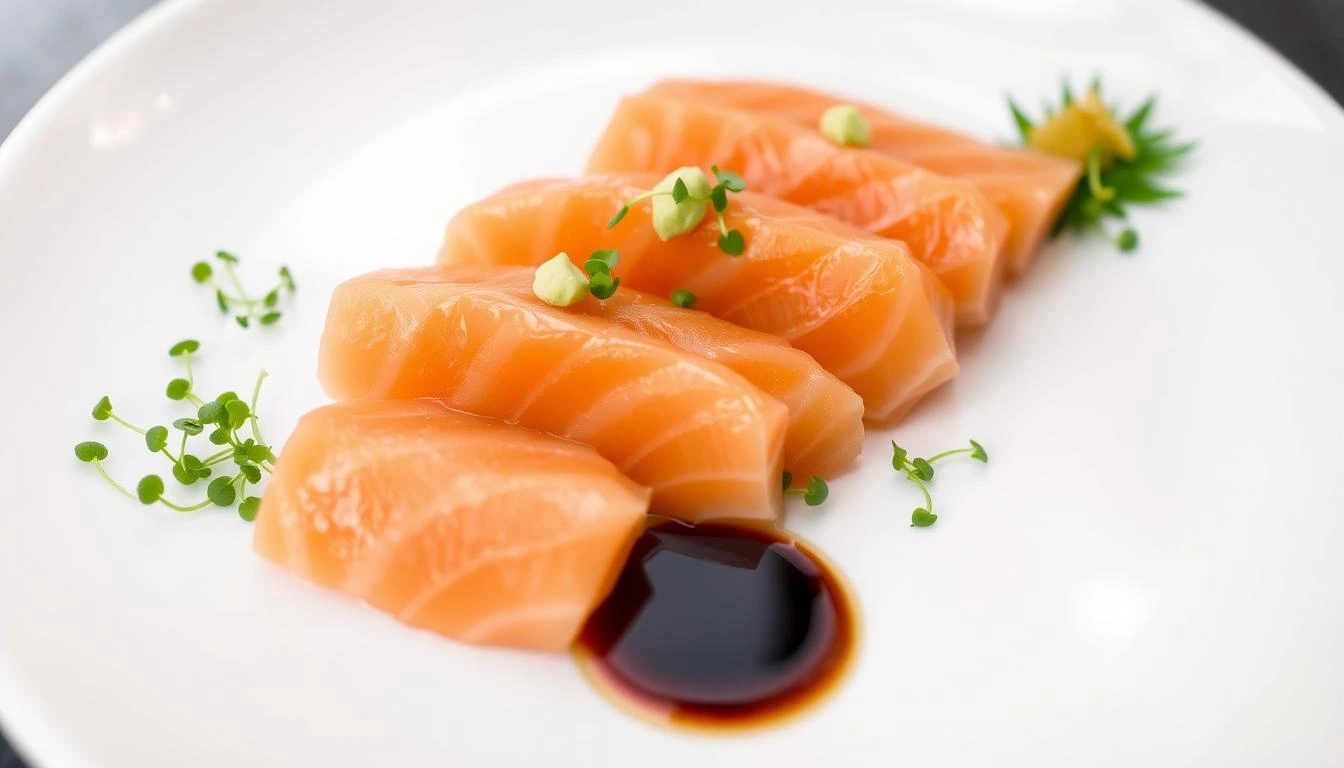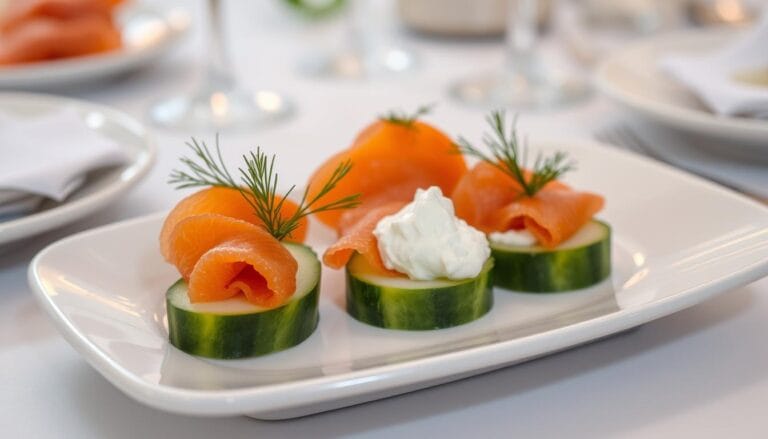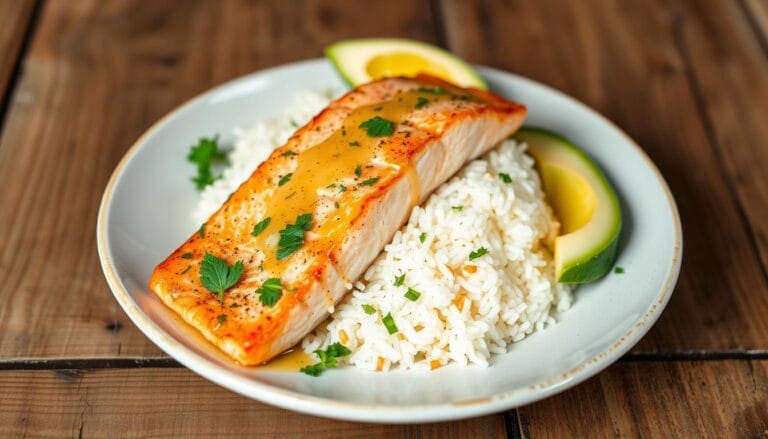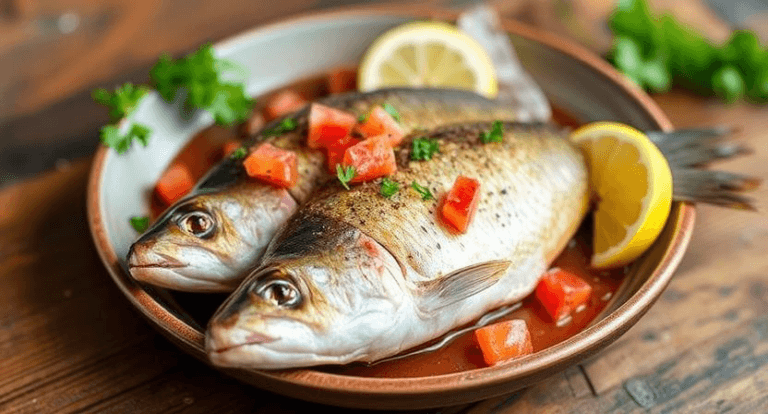Salmon Sashimi: A Delectable Japanese Delicacy
Table of Contents
Imagine sitting at a traditional Japanese izakaya. The warm ambiance and the aroma of fresh dishes fill the air. You can’t wait to try the fresh salmon sashimi.
The first slice is a burst of flavor and texture. It’s more than just a meal; it connects you to Japanese culture. Japanese chefs put their heart into their work, making every bite special.
Whether it’s a favorite dish or something new, salmon sashimi is a treat. It invites you to enjoy every moment.
Key Takeaways
- Salmon sashimi is a highly regarded Japanese delicacy known for its rich flavor.
- It requires fresh sushi-grade salmon and meticulous preparation techniques.
- This dish is traditionally enjoyed with minimal garnishes to let the fish shine.
- Salmon sashimi is low in calories and high in protein, making it a healthy choice.
- Considering the quality of ingredients is crucial for optimal sashimi experience.
- It offers a unique cultural experience through its preparation and presentation.
What is Salmon Sashimi?
Salmon sashimi is a dish that comes from Japan. It’s made with raw salmon sliced very thin. It’s served without rice, making it different from sushi.
This dish is a big part of Japanese food culture. It’s known for its pure taste, letting the fish’s flavor stand out.
Definition and Origin
Salmon sashimi is raw salmon sliced thin and served without rice. It’s a big hit in Japan, even more than bluefin tuna. It became popular in the mid-1980s with the arrival of Norwegian salmon.
Cultural Significance in Japanese Cuisine
Salmon sashimi is a key part of Japanese food traditions. It’s all about fresh, seasonal ingredients. It’s often eaten with soy sauce, wasabi, and pickled ginger.
This dish is more than just food. It shows the skill and art of Japanese chefs. The salmon is cut into 3 cm slices for the best look and taste.
| Aspect | Details |
|---|---|
| Popularity | Most popular sashimi choice in Japan |
| Origin | Mid-1980s with Norwegian salmon |
| Common Pairings | Soy sauce, wasabi, pickled ginger |
| Recommended Cut | Salmon loin, 3 cm thick slices |
| Cultural Role | Showcases Japanese culinary artistry |
The Art of Preparing Salmon Sashimi
Preparing salmon sashimi needs careful steps to ensure quality and safety. It starts with finding fresh salmon. Choosing salmon sashimi grade fish means you get the best ingredients for a great sashimi experience.
Sourcing Fresh Salmon
For the freshest salmon, go to a trusted fish market. Farmed salmon is safer because it’s less likely to have parasites. When buying, pick whole salmon to check for freshness.
- Bright red gills
- Clear, bulging eyes
- Firm flesh with a clean marine smell
If you clean the salmon yourself, make sure to remove all blood and organs. Clean your work area and tools well for safety.
Necessary Kitchen Tools
You’ll need the right tools for the best sashimi. Start with a sharp Japanese sashimi knife, like a Yanagiba. Also, have a clean cutting board and disinfectants ready. Keeping everything clean is key.
Step-by-Step Preparation Process
Start by filleting the salmon. Use a large knife to cut along the spine. Remove ribs and fat for a cleaner dish.
After filleting, remove bones with pliers. Then, sanitize your area before the final steps.
When slicing, cut against the grain for tenderness. Adjust the thickness for different presentations. For nigiri, slice at a 45-degree angle smoothly.
| Freshness Indicator | Description |
|---|---|
| Gills | Bright red in color |
| Eyes | Clear and bulging |
| Flesh | Firm texture, clear appearance |
| Smell | Clean marine odor, not fishy |
By following these steps, you’ll improve your sashimi skills. You’ll also enjoy the pure taste and quality of this dish.
Types of Salmon Used for Sashimi
Choosing the right salmon is key to great sashimi. Each type of salmon has its own taste and texture. Knowing these differences can make your sashimi experience even better.
Atlantic Salmon
Atlantic salmon is a top pick for sashimi. It has a rich, buttery taste and a smooth texture. You can find it in many stores, making it easy to get.
It’s great for sashimi and many other dishes. Its versatility is unmatched.
Pacific Salmon Varieties
Pacific salmon includes Chinook and Sockeye. Chinook is fatty, making it very rich. Sockeye has a bold flavor and bright red color.
Both are excellent for sashimi. They add depth and color to your dish.
Wild vs. Farmed Salmon
Wild and farmed salmon have different tastes and textures. Wild salmon is leaner but has a stronger flavor. Farmed salmon is fattier, making it creamy.
Knowing these differences helps you choose the best salmon for sashimi.
| Type of Salmon | Flavor Profile | Texture | Preferred for Sashimi |
|---|---|---|---|
| Atlantic | Rich and buttery | Smooth | Yes |
| Chinook | Luxurious richness | Fatty | Yes |
| Sockeye | Bold and flavorful | Firm | Yes |
| Wild Salmon | Robust | Lean | Yes |
| Farmed Salmon | Buttery | Fatty | Yes |
Best Pairings for Salmon Sashimi
To enjoy your salmon sashimi recipe, choose the right pairings. This will make your meal better. Try traditional condiments, sides, and drinks to bring out the flavors and textures.
Traditional Condiments
Use these traditional condiments to enhance your salmon sashimi:
- Soy sauce: Adds a savory depth.
- Wasabi: Gives a sharp, spicy kick.
- Pickled ginger: Refreshes your palate.
Complementary Sides
Balance your meal with these sides:
- Miso soup: Adds umami richness.
- Seaweed salad: Provides a refreshing crunch.
- Cucumber salad: Is light and crisp.
Beverage Suggestions
Choose the right drink to go with your salmon sashimi. Consider these options:
- Chilled sake: A traditional choice.
- Light beers: Their crispness complements the sashimi.
- Dry Riesling: Pairs well with sashimi’s simplicity.
Creating a memorable meal with salmon sashimi is more than just the fish. It’s about choosing the right condiments, sides, and drinks. By doing so, your meal will be rich and fulfilling, making every bite special.
| Pairing Type | Examples |
|---|---|
| Condiments | Soy sauce, Wasabi, Pickled ginger |
| Complementary Sides | Miso soup, Seaweed salad, Cucumber salad |
| Beverages | Chilled sake, Light beer, Dry Riesling |
Nutritional Benefits of Salmon Sashimi
Adding delicious salmon sashimi to your meals can boost your health. This Japanese dish is loved for its taste and health benefits. It’s packed with nutrients that help keep you well.
Richness in Omega-3 Fatty Acids
Salmon sashimi is known for its omega-3 fatty acids. Eating omega-3 rich fish like salmon can lower heart disease risk. These fats help control blood pressure and reduce inflammation.
Studies show eating salmon a few times a week can greatly reduce heart disease risk. It’s a great choice for improving heart health.
Protein Content and Health Benefits
A 3-ounce serving of salmon sashimi has about 18.8 grams of protein. This is a big part of your daily protein needs, helping muscles and body strength. Salmon also has important vitamins and minerals like Vitamin B12, Vitamin D, and selenium.
These nutrients are key for energy, bone health, and a strong immune system.
Low Calorie, High Satisfaction
Salmon sashimi has about 175 calories per 3-ounce serving. It’s low in carbs and fiber, making it good for low-carb diets. The high protein keeps you full, helping you stay healthy and enjoy this tasty dish.
| Nutrient | 3-Ounce Serving of Salmon | Daily Value (%) |
|---|---|---|
| Calories | 175 | – |
| Protein | 18.8 g | 40.8% (Females) |
| 33.6% (Males) | ||
| Fat | 10.5 g | 30-42% |
| Vitamin B12 | – | 99.1% |
| Vitamin D | – | 55.9% |
| Vitamin B6 | – | 32.4% |
| Thiamine | – | 24.1% |
Popular Salmon Sashimi Dishes
Salmon sashimi opens up a world of flavors. It shows how versatile salmon can be in different dishes. Each dish brings out the freshness and quality of the salmon in its own way.
Classic Nigiri and Sashimi Preparations
Salmon sashimi is often served as nigiri. This means fresh salmon slices on small rice balls. It’s a simple yet elegant way to enjoy the fish’s pure taste.
Contemporary Fusion Dishes
Modern chefs are getting creative with salmon sashimi. You might see it on avocado toast or in tacos. These dishes mix flavors in exciting ways, pleasing many palates.
Sushi Rolls Featuring Salmon Sashimi
Salmon sashimi is a key ingredient in sushi rolls. It adds richness and texture. Whether in a classic roll or a new creation, it brings out the salmon’s buttery taste.
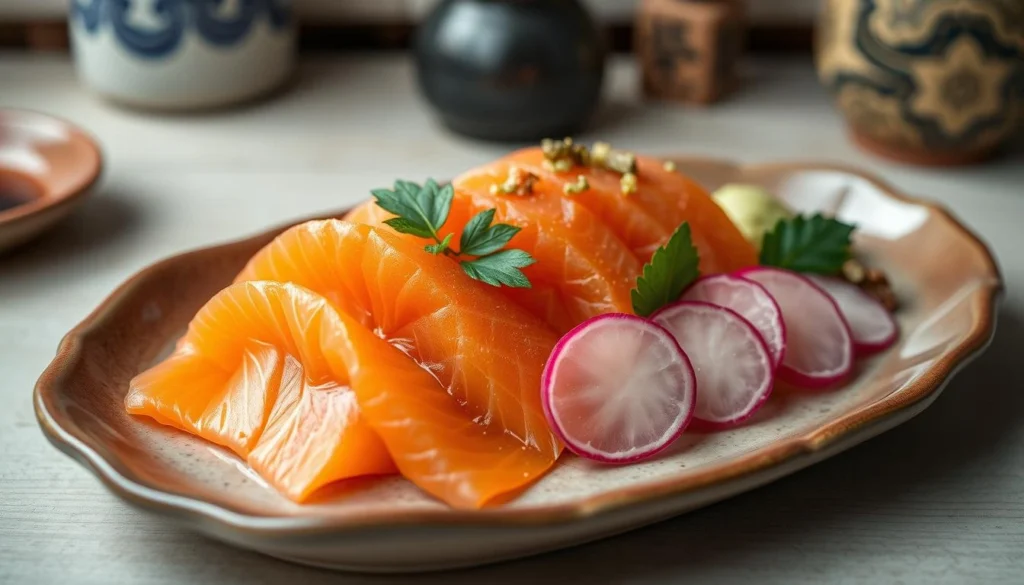
| Dish Type | Preparation Time | Serving Size | Key Ingredients |
|---|---|---|---|
| Nigiri | 10 minutes | 4 servings | 12 ounces sashimi grade salmon, sushi rice |
| Avocado Toast | 10 minutes | 2 servings | Salmon sashimi, avocado, toast |
| Salmon Sushi Rolls | 10 minutes | 4 rolls | Salmon sashimi, nori, sushi rice |
Common Myths About Salmon Sashimi
There are many myths about salmon sashimi that can confuse people. Knowing the truth can make you enjoy this Japanese dish more. Let’s clear up some common misconceptions.
Myth: All Salmon is Safe for Raw Consumption
Not all salmon is safe to eat raw. Only sushi-grade salmon, which has been thoroughly checked, is okay for sashimi. This salmon meets strict standards to reduce the risk of getting sick from food. Always check with your supplier about the salmon’s safety before eating it raw.
Myth: Sashimi is Just Sushi
Many think sashimi and sushi are the same. But sashimi is raw fish served without rice, focusing on the fish’s quality. Sushi, however, includes rice and other ingredients with raw or cooked seafood. Knowing this difference helps you appreciate both dishes more.
Myth: Sashimi Has to Be Expensive
Some believe high-quality salmon sashimi costs a lot. But this isn’t always true. There are many affordable options available. You can find delicious salmon sashimi without spending a lot, showing that quality doesn’t always mean high cost.
Tips for Enjoying Salmon Sashimi
Exploring fresh salmon sashimi can be a delightful experience. Whether you’re dining out or making it at home, knowing the details can make it even better.
Choosing the Right Restaurant
Finding a good sushi place is key for great salmon sashimi. Look for places that value quality and have skilled chefs. A chef’s skill in slicing and presentation greatly affects taste and texture.
One Fish Raw Bar is a great choice. They focus on culinary excellence and offer a unique sashimi experience.
DIY Experience at Home
For a DIY sashimi adventure, get sushi-grade salmon. It should have bright eyes, firm flesh, and a mild smell. Use the right slicing techniques, like hira-zukuri, to improve taste and look.
Pair it with quality soy sauce and fresh wasabi for a real taste experience.
Savoring the Flavors
Enjoy each piece of salmon sashimi slowly. Notice its luxurious texture and the fish’s essence. This dish is all about simplicity.
Traditionally, eat pickled ginger between sashimi types to enjoy each flavor. Sake or green tea can also enhance the experience, letting the salmon’s flavors stand out.
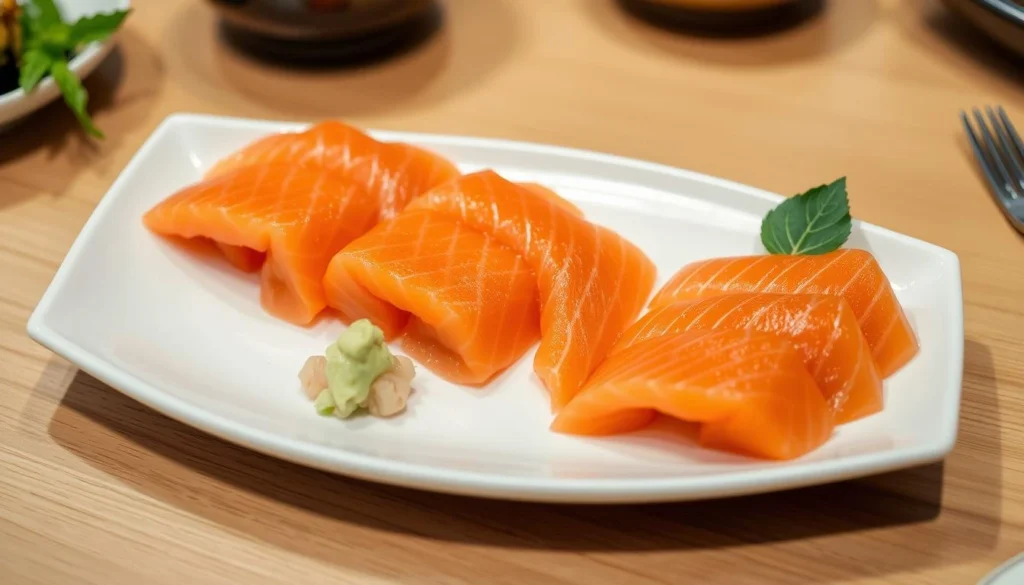
| Aspect | Details |
|---|---|
| Freshness | Critical for taste and texture |
| Preparation | Involves skilled slicing techniques |
| Presentation | Beautifully arranged for visual appeal |
| Accompaniments | Quality soy sauce and fresh wasabi |
| Etiquette | Cleansing the palate with pickled ginger |
Conclusion: Embracing Salmon Sashimi
Authentic salmon sashimi is a true gem in Japanese cuisine. It’s known for its smooth texture and deep flavor. It’s not just a feast for the eyes but also great for your health, packed with omega-3s and vitamins.
Whether you’re a sashimi fan or new to it, trying salmon sashimi is exciting. It can make your mealtime special. You can even try making it at home or visit a sushi place to see the skill involved.
FAQ
What is salmon sashimi?
Salmon sashimi is a Japanese dish with thinly sliced, raw salmon. It highlights the freshness and quality of the ingredients. This lets the fish’s natural flavors shine.
How do I know if the salmon is sushi-grade?
Look for sushi-grade salmon from trusted vendors. This fish is processed safely for raw eating.
What are the best condiments to serve with salmon sashimi?
Soy sauce, wasabi, and pickled ginger are great for salmon sashimi. They bring out the fish’s rich flavors.
What types of salmon are best for sashimi?
Atlantic, Chinook, and Sockeye salmon are top choices for sashimi. Each variety offers unique flavors and textures.
How can I prepare salmon sashimi at home?
Start with sushi-grade salmon. Use a sharp knife to slice it thinly against the grain. This ensures the best texture.
Is salmon sashimi healthy?
Yes, it’s packed with omega-3s, protein, and low in calories. It’s a great choice for a healthy diet.
Can salmon sashimi be made with farmed salmon?
Definitely, farmed salmon works well for sashimi. But wild salmon is often preferred for its leaner meat and richer taste. Both can be delicious when prepared right.
What common myths exist about salmon sashimi?
Some think all salmon is safe for raw eating. But only sushi-grade salmon is safe for sashimi. Sashimi is also often confused with sushi, which has rice. Sashimi focuses on raw fish.
What are some contemporary dishes that feature salmon sashimi?
Modern dishes include salmon sashimi on avocado toast, in tacos, or in sushi rolls. These dishes show the fish’s versatility while keeping its quality.
What is the cultural significance of salmon sashimi in Japanese cuisine?
Salmon sashimi represents the Japanese value of “umami.” It shows respect for quality ingredients. It’s a key part of traditional Japanese meals, highlighting the skill of Japanese chefs.

